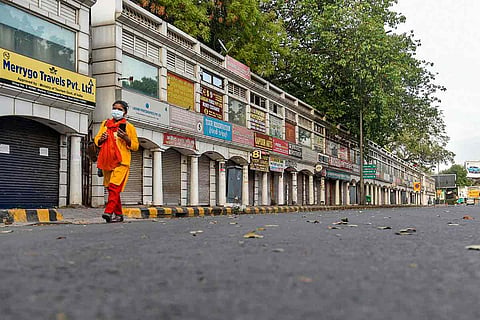

Prime Minister Narendra Modi on Tuesday announced an extension of the nationwide lockdown by another 19 days. While many have wondered if this is now the new normal, others have questioned whether the 21-day lockdown had any impact on the growth of the virus in India.
There is some reason for cautious optimism. Data from different sources suggest there has been some ‘flattening of the curve’.
In a series of tweets on Monday, Shamika Ravi, former Fellow of the Brookings Institute, said, “India is flattening the curve. The growth rate has shown a consistent decline - from April 6th onwards - approximately 2 weeks after the #Lockdown . Active cases are doubling every 7 days.”
#DailyUpdate #COVID2019
— Shamika Ravi (@ShamikaRavi) April 13, 2020
India is flattening the curve. The growth rate has shown a consistent decline - from April 6th onwards - approximately 2 weeks after the #Lockdown . Active cases are doubling every 7 days. pic.twitter.com/in1PbptlW8
On April 6, India reported 4778 cases, according to India COVID-19 tracker, a crowdsourced initiative. The cases more than doubled to 10,455 on April 13, suggesting that active cases were now doubling every 7 days.
Prior to this, cases were doubling every four days. India recorded 2059 cases on April 1 and this number doubled by April 5 to 4289 cases.
In other words, as Shamika notes, while the number of cases may be rising daily, the growth rate has declined since April 6.
As far as deaths go, the cases are also doubling every five days (April 8 - 184 deaths to April 13- 361 deaths), compared to every four days earlier (March 31- 49 deaths to April 4- 99 deaths).
Analysis by the Institute of Mathematical Sciences in Chennai also showed that the rate of infections has also declined. The reproduction value also known as the R Naught or R0, which is the average number of people the virus can infect fell to 1.55 between April 6 and April 11 compared to 1.83 persons infected earlier. In simple words, the novel coronavirus infected 1.55 persons as compared to 1.83 persons it infected earlier.
So, is there cause to celebrate?
Speaking to TNM, Dr Jayaprakash Muliyil, renowned epidemiologist and former Principal of the Christian Medical College (CMC), Vellore said, “We think there must have been some impact of the lockdown. The number that you calculate in terms of R value can come down with these kinds of manoeuvres (lockdown). It doesn’t mean that the transmission has stopped. It is just that it is continuing at a reduced rate.”
He added that in qualitative terms there has been some flattening of the curve, noting, “I expect there has been some flattening. If there had been no flattening at all, then I would have been very surprised.”
Can we expect the cases to rise again when the lockdown is lifted?
Dr Jayaprakash said it is natural for the cases to rise post lockdown. “When lockdown is lifted, it will go back to the same accelerating phase. If you look at the laws of mass action, so when you reduce the number of contacts, there will be a reduction of infections. If your contacts go back to as earlier, then there is a rise in infections. Whatever you do in a lockdown period, where there is an established infection going on, there will be some reduction. As long as the R effective value is above 1, there is continued progression in the epidemic,” he explained.
So what is the way forward given that an indefinite lockdown isn’t sustainable?
The epidemiologist said, “Some people believe it is possible to keep on hammering and get the virus out. I don’t think it will be possible. If it is, it will be good. Theoretically, it cannot happen.”
He went on to explain that once an infection is established, one can slow it down by measures like lockdown and social distancing. But that it will rise again once the measures are lifted. “This process will go on until we reach an R effective of 1 (when the virus infects an average of 1 person).”
Dr Jayaprakash explained that the SARS-CoV-2 virus that causes the COVID-19 disease can reach endemicity (when the disease is present in the community at all times but at a lower frequency) because of low contact rate. However, the cases will rise when contacts between persons increase. Another way to reach endemicity, he said, is when “less number of persons are susceptible to the virus and there is a gathering of immunity in the community. Then it will be a permanent fixture. That is there won’t be an epidemic.”